A new coronavirus variant is spreading across the United States, but experts have urged people not to worry.
The mutant strain ? called HV.1 ? is a mutation on the EG.5 variant that raised concerns earlier this year.
It is now dominant in the US in 25 percent of cases, with experts saying it is more transmissible than other variants. There is no evidence that it is more likely to cause serious illness.
However, experts are not sounding the alarm about the mutant strain, saying there will ‘always be new variants’ as Covid continues to spread and mutate.
However, there are concerns about America’s slow booster programme, with the rollout this weekend branded ‘terrible’, with less than three per cent of Americans already signed up a month after the rollout.
Covid cases and hospital admissions are currently on a downward trend and deaths are declining, although experts warn that cold weather, which causes people to spend more time indoors, could lead to a rise in cases.
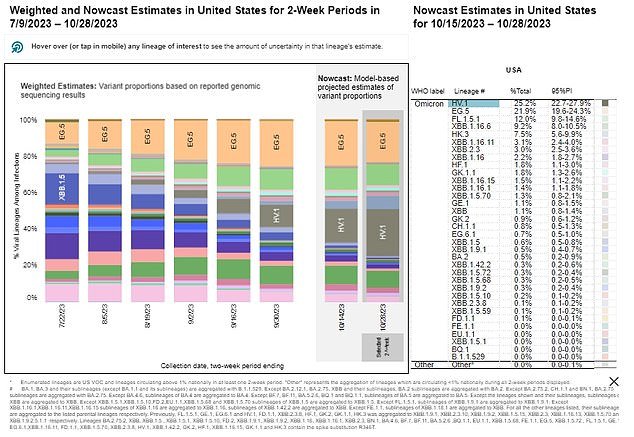
The above shows CDC estimates of Covid variants spreading across the US. This shows that HV.1 is now dominant and is responsible for an estimated 25 percent of infections
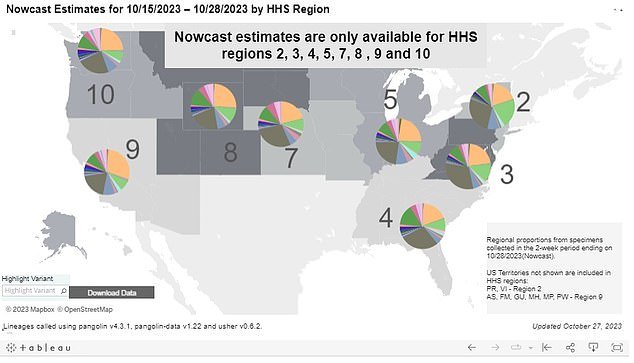
This map shows how HV.1 is currently more common on the East Coast rather than the West Coast
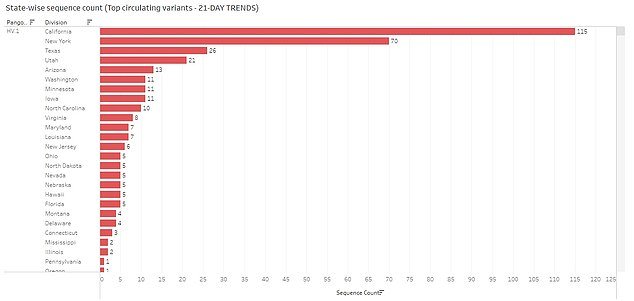
The data above shows the number of HV.1 cases reported by state. California and New York have the most infections
Dr. Amesh Adalja, an infectious disease expert at Johns Hopkins University, said WION: ‘It is important to recognize that there will always be new variants of SARS-CoV-2.
?(This is) just like any other endemic respiratory virus, and most of them won’t be of concern to anyone.?
Dr. Ross Kedl, an immunologist at the University of Colorado Anschutz School of Medicine, added: ‘All people know at this point is that it is increasing.
“There’s no evidence it’s more serious.”
And dr. William Schaffner, an infectious disease expert at the Vanderbilt University School of Medicine in Tennessee, said Prevention: ‘I don’t think people should worry much about this.
‘Some of the symptoms recorded include coughing, fatigue, congestion and a runny nose. That sounds a lot like a common cold.’
Scientists say Covid will continue to mutate and create new variants as new cases emerge.
But they add that there is little need to fixate on every new strain that emerges, as most will not increase the risk of serious disease.
HV.1 was first detected in Costa Rica in late July, according to Covid variant tracking website outbreak.info.
The disease has now spread to more than 41 countries ? including Britain, Canada and Israel ? and a total of 4,397 cases have been detected, mainly in the United States.
However, this is probably a huge underestimate, because in many cases variants are not checked for.
The mutant strain was spotted in the US in July and has since been responsible for an increasing share of cases.
At the end of August, this was behind three percent of cases, according to figures from the Centers for Disease Control and Prevention (CDC).
However, in the last week of September it was behind 12 per cent of all Covid cases, while the latest estimates for this month say it is now behind one in four infections.
California ? America’s most populous state ? has the most cases with 115 recorded, followed by New York ? a ‘whistleblower’ state ? with 70 cases.
The mutant strain has several mutations on the spike protein, which experts say makes it better able to evade immunity and infect cells.
There are also currently no signs of it causing any other symptoms, with doctors likening the symptoms – including coughing and runny nose – to the common cold.
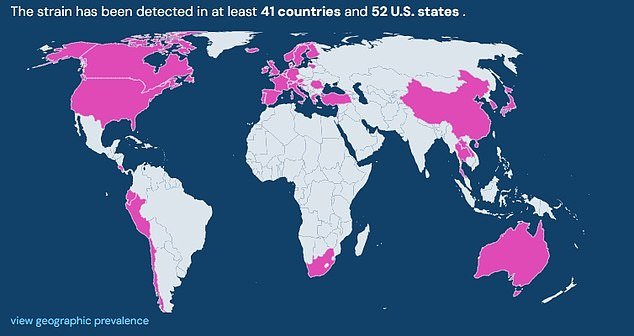
The map above shows the countries that have reported at least one case of HV.1
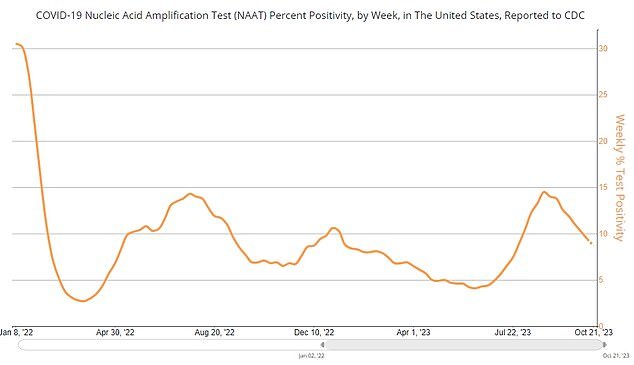
The above shows the positivity rate for Covid tests in the US, or the percentage that detects the virus. This is an indicator of the situation on site
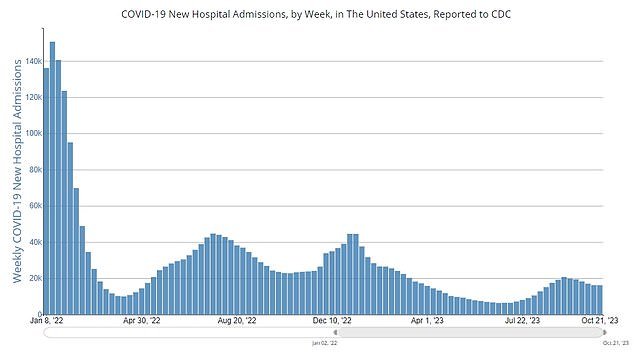
This shows that Covid hospital admissions are being recorded in the US. The latest data shows a five percent drop in numbers
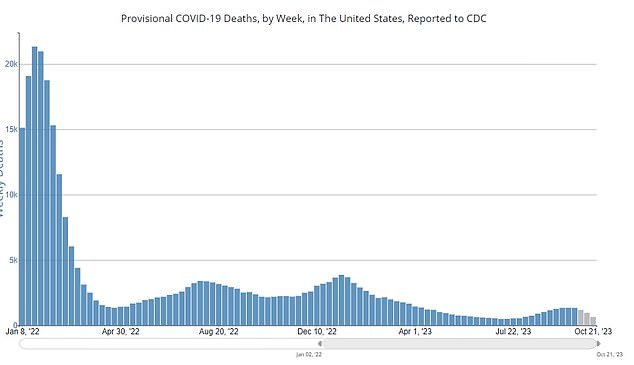
Above you can see the number of Covid deaths per week. This measure is currently leveling off
The US is currently rolling out a revamped Covid booster vaccine that has been made available to everyone over the age of six months. However, top advisers say only people over 65 should get vaccinated.
The vaccine is based on the XBB.1.5 Covid variant – which was dominant this summer – with experts saying HV.1 is a ‘grandchild’ of this strain.
They suggest the vaccine will still work well against severe disease caused by HV.1 because it has only a few mutations left.
It comes as the number of Covid cases and hospital admissions continues to fall nationally.
The latest CDC data showed that the positivity rate ? the percentage of tests that detected the virus ? fell to 8.7 percent in the week to October 21, compared to 9.4 percent the week before.
There were also 13,036 Covid patients admitted to hospital in the week to October 21, the latest available, down 4.6 per cent from 13,652 at the same time last week.
By comparison, at the peak of the past two years, there were 145,636 Covid patients in hospitals on January 8, 2022.
Covid-19 deaths are currently leveling off at 1,347 per week, with preliminary data suggesting this number could soon start to fall.
However, some experts warn that indicators will trend upward in the coming weeks as cooler weather leads to more people staying indoors.
There are also gatherings for the upcoming holidays, including Thanksgiving and Christmas, which will result in different generations coming together ? potentially fueling the spread of Covid.
Dr. Kelly Oakeson, chief scientist at the Utah Department of Health, told the Deseret News, ?If this happened in the summer, it might have less of an impact on everything.
‘But now that it’s happening in the fall/winter, people are indoors, it’s getting colder outside and there are more holidays.
?You’ll probably definitely see an increase in cases. Is that controlled by HV.1? Is that determined solely by seasonality, what time of year it is?
“No, it’s probably a combination of all those things… we’ve seen this year after year now.”
Concerns have also been raised about the Covid variant JN.1, a mutated version of the strain BA.2.86, or ‘Pirola’, which scientists warned could cause a new wave of infections.
There have been 51 cases reported worldwide so far in 11 countries, including the United States, the United Kingdom and Germany.
Some scientists fear this strain is more transmissible than others and could cause a new wave of infections.
Dr. Oakeson described this mutant strain as “alarming.”
?We’ll definitely keep an eye on it,? she said.
?I’m not sure I’m at the same level of concern as I am with BA.2.86, just because it’s a descendant of that and we haven’t seen that development in the US as it has in other parts of the US. world.’
